English-only rule lacks flexibility
The arguments given by Dr Caldwell are echoed by my 24 years of English language teaching experiences in six different secondary schools in Hong Kong. They have been proved valid in teaching students of different streams, namely, Chinese medium of instruction and English medium of instruction.

I refer to the letter by John A. W. Caldwell ("New studies show Chinese can be used to teach English", February 21).
The arguments given by Dr Caldwell are echoed by my 24 years of English language teaching experiences in six different secondary schools in Hong Kong. They have been proved valid in teaching students of different streams, namely, Chinese medium of instruction and English medium of instruction.
I strongly believe that using Chinese wisely and skilfully in the process of English teaching can not only dispel students' fear of learning the language but also enhance their motivation.
This holds true, in particular, when we teach English idioms or sayings. For instance, when the Chinese equivalents of "an eye for an eye" and "beauty is in the eye of the beholder" are given to students simultaneously, we can feel their strong desire to learn more.
Nothing is lost but, instead, gained in translation during the whole process of teaching. Such a practice enlivens and broadens students' learning dimension.
Moreover, bilingual teaching is highly effective when it comes to grammar teaching. Since Cantonese-speaking students usually make mistakes in writing English, thanks to their mother-tongue interference, an immediate analysis and contrast between Chinese (or Cantonese) and English can root out their problems.